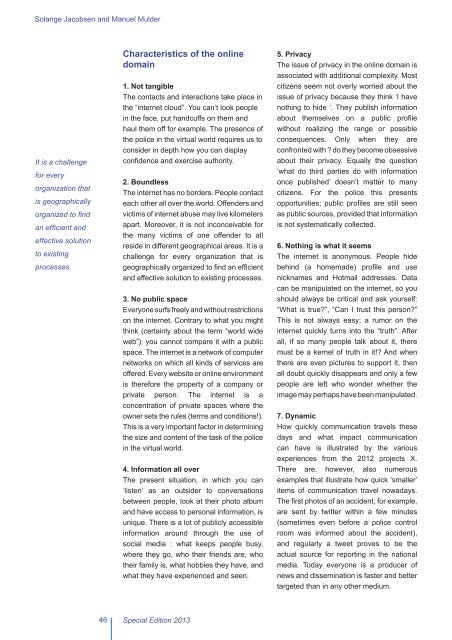ora-schriften-s-2013
ora-schriften-s-2013
ora-schriften-s-2013
You also want an ePaper? Increase the reach of your titles
YUMPU automatically turns print PDFs into web optimized ePapers that Google loves.
Solange Jacobsen and Manuel Mulder<br />
It is a challenge<br />
for every<br />
organization that<br />
is geographically<br />
organized to find<br />
an efficient and<br />
effective solution<br />
to existing<br />
processes.<br />
Characteristics of the online<br />
domain<br />
1. Not tangible<br />
The contacts and interactions take place in<br />
the “internet cloud”. You can’t look people<br />
in the face, put handcuffs on them and<br />
haul them off for example. The presence of<br />
the police in the virtual world requires us to<br />
consider in depth how you can display<br />
confidence and exercise authority.<br />
2. Boundless<br />
The internet has no borders. People contact<br />
each other all over the world. Offenders and<br />
victims of internet abuse may live kilometers<br />
apart. Moreover, it is not inconceivable for<br />
the many victims of one offender to all<br />
reside in different geographical areas. It is a<br />
challenge for every organization that is<br />
geographically organized to find an efficient<br />
and effective solution to existing processes.<br />
3. No public space<br />
Everyone surfs freely and without restrictions<br />
on the internet. Contrary to what you might<br />
think (certainly about the term “world wide<br />
web”), you cannot compare it with a public<br />
space. The internet is a network of computer<br />
networks on which all kinds of services are<br />
offered. Every website or online environment<br />
is therefore the property of a company or<br />
private person. The internet is a<br />
concentration of private spaces where the<br />
owner sets the rules (terms and conditions!).<br />
This is a very important factor in determining<br />
the size and content of the task of the police<br />
in the virtual world.<br />
4. Information all over<br />
The present situation, in which you can<br />
‘listen’ as an outsider to conversations<br />
between people, look at their photo album<br />
and have access to personal information, is<br />
unique. There is a lot of publicly accessible<br />
information around through the use of<br />
social media : what keeps people busy,<br />
where they go, who their friends are, who<br />
their family is, what hobbies they have, and<br />
what they have experienced and seen.<br />
5. Privacy<br />
The issue of privacy in the online domain is<br />
associated with additional complexity. Most<br />
citizens seem not overly worried about the<br />
issue of privacy because they think ‘I have<br />
nothing to hide ‘. They publish information<br />
about themselves on a public profile<br />
without realizing the range or possible<br />
consequences. Only when they are<br />
confronted with ? do they become obsessive<br />
about their privacy. Equally the question<br />
‘what do third parties do with information<br />
once published’ doesn’t matter to many<br />
citizens. For the police this presents<br />
opportunities; public profiles are still seen<br />
as public sources, provided that information<br />
is not systematically collected.<br />
6. Nothing is what it seems<br />
The internet is anonymous. People hide<br />
behind (a homemade) profile and use<br />
nicknames and Hotmail addresses. Data<br />
can be manipulated on the internet, so you<br />
should always be critical and ask yourself:<br />
“What is true?”, “Can I trust this person?”<br />
This is not always easy; a rumor on the<br />
internet quickly turns into the “truth”. After<br />
all, if so many people talk about it, there<br />
must be a kernel of truth in it!? And when<br />
there are even pictures to support it, then<br />
all doubt quickly disappears and only a few<br />
people are left who wonder whether the<br />
image may perhaps have been manipulated.<br />
7. Dynamic<br />
How quickly communication travels these<br />
days and what impact communication<br />
can have is illustrated by the various<br />
experiences from the 2012 projects X.<br />
There are, however, also numerous<br />
examples that illustrate how quick ‘smaller’<br />
items of communication travel nowadays.<br />
The first photos of an accident, for example,<br />
are sent by twitter within a few minutes<br />
(sometimes even before a police control<br />
room was informed about the accident),<br />
and regularly a tweet proves to be the<br />
actual source for reporting in the national<br />
media. Today everyone is a producer of<br />
news and dissemination is faster and better<br />
targeted than in any other medium.<br />
46 Special Edition <strong>2013</strong>





